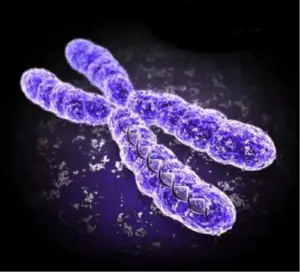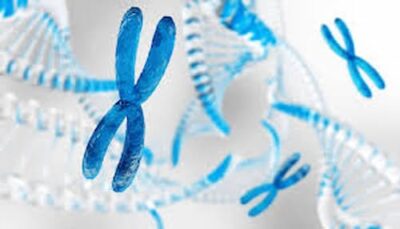Dogs, like all mammals, have a set of chromosomes that carry their genetic information. Chromosomes are long, coiled strands of DNA located in a cell’s nucleus. They contain all the genetic instructions an organism needs to develop and function. The number of chromosomes in an organism is a critical characteristic that can differentiate one species from another. So, the question of how many chromosomes do dogs have is vital for understanding their genetic makeup.
All dogs have 39 pairs of chromosomes which total 78 chromosomes in total. This includes one pair of sex chromosomes, which determine the animal’s gender, with females having two X chromosomes and males having one X and one Y chromosome.
The remaining 38 pairs of chromosomes are autosomes and carry most of the animal’s genetic information. This means that dogs have two copies of each gene, one from each parent, which can lead to variation in traits such as coat color, size, and temperament.
The number of chromosomes in dogs is similar to other mammals like humans, which also have 46 chromosomes. While the number of chromosomes doesn’t necessarily determine the complexity of an organism, the amount and organization of genetic material on those chromosomes do.
By comparing the number and organization of chromosomes, scientists can better understand the evolutionary relationships between different species and even infer the evolutionary mechanisms that led to the current chromosomal organization.
How many chromosomes do dogs have?

Dogs, like all mammals, have a set of chromosomes that contain their genetic information. Chromosomes are long, coiled strands of DNA located in a cell’s nucleus. The number of chromosomes can vary among different species, but in dogs, the number is fixed at 78. These chromosomes are grouped into 39 pairs, each containing one chromosome inherited from the mother and one from the father during the fertilization process.
Each chromosome contains many genes, which are the basic units of heredity. Genes carry the instructions for the development and function of the body’s cells, tissues, and organs. They are responsible for determining a wide range of traits, from a dog’s coat color and pattern to its size and behavior.
The chromosomes in dogs are also grouped into different categories, like autosomes and sex chromosomes. Autosomes are the chromosomes that determine all the physical and behavioral characteristics that are not related to the sex of the dog. Dogs have 38 pairs of autosomes, in total 76. On the other hand, the sex chromosomes determine the gender of the dog, females have two X chromosomes and males have one X and one Y chromosome.
In addition to determining physical and behavioral traits, the chromosomes in dogs also play a crucial role in the dog’s overall health. Chromosomes can carry mutations, or changes, in the DNA that can lead to certain genetic disorders. These disorders can range from mild to severe and impact the dog’s quality of life.
Chromosomes are the carrier of genetic information in dogs and play a significant role in the development and function of the body, behavior, and overall health of the dog. Understanding the number of chromosomes, genetic makeup, and how the chromosomes function can give us insight into breeding and help us understand and manage certain genetic disorders.
What is the chromosome count in dogs?
The chromosome count in dogs is 78. They have 39 pairs of chromosomes, each containing one inherited from the mother and one from the father. This set of chromosomes contains all the genetic information that determines the physical and behavioral characteristics of the dog.
Each chromosome contains many genes, which are the basic units of heredity and responsible for determining a wide range of traits, such as coat color, pattern, size, and behavior.
The chromosomes in dogs are also grouped into different categories, autosomes and sex chromosomes. Autosomes are the chromosomes that determine all the physical and behavioral characteristics that are not related to the sex of the dog.
Dogs have 38 pairs of autosomes in total 76. On the other hand, the sex chromosomes determine the gender of the dog, females have two X chromosomes and males have one X and one Y chromosome.
How does the number of chromosomes in dogs compare to humans?

Dogs and humans are different species, and as such, they have other numbers of chromosomes. Chromosomes are the structures in cells that carry genetic information and come in pairs. The number of chromosomes in a species is often characteristic and can be used to distinguish different species from one another.
Humans have 23 pairs of chromosomes for a total of 46 chromosomes. Each pair consists of one chromosome inherited from the mother and one from the father. These 46 chromosomes contain all of the genetic information needed for the development and functioning of the human body.
On the other hand, dogs have 39 pairs of chromosomes for a total of 78. These 78 chromosomes also contain all of the genetic information needed for the development and functioning of the canine body.
While the number of chromosomes is different between dogs and humans, the organization of the genetic information on the chromosomes is similar. Both species have an equal number of genes responsible for similar functions.
The DNA within each chromosome is also chemically identical in dogs and humans. The differences in the number of chromosomes are likely due to the accumulation of genetic mutations over time, which have led to the evolution of different species.
Are there any differences in chromosome number among different breeds of dogs?
Different breeds of dogs can have slight variations in the number of chromosomes. However, dogs of various breeds generally have the same number of chromosomes, 78. This is because dogs are all members of the same species, Canis lupus familiaris, and have the same basic genetic makeup.
However, some breeds of dogs have been selectively bred to have specific characteristics. This selective breeding can lead to small changes in the genetic makeup of the species, which can result in slight variations in the number of chromosomes.
Chromosomal structural changes like inversions, translocations, or deletions often cause these variations. These structural changes do not change the total number of chromosomes but the position of genes.
It’s important to note that such variations, though found in a few breeds, are not typical, and the majority of dog breeds have the same number of chromosomes. Also, such variations have yet to be studied thoroughly. Thus, the number of species affected and the effects of the chromosomal changes on their health and behavior still need to be clearly understood.
Overall, the number of chromosomes in dogs is generally consistent across different breeds. Variations are usually minor, poorly understood, and do not affect the dogs’ ability to interbreed. Thus, the differences in the appearance and behavior of different breeds of dogs are primarily the result of selective breeding for specific traits.
Can the number of chromosomes in dogs affect their health or behavior?

The number of chromosomes in dogs does not directly affect their health or behavior. However, changes in the structure or number of chromosomes can cause genetic disorders. Chromosomal abnormalities can occur due to errors in cell division, which can lead to various health problems.
Some examples include Down syndrome in humans and Klinefelter syndrome in dogs, which are caused by an extra copy of a specific chromosome.
Chromosomal abnormalities can cause a wide range of physical and developmental problems in dogs and vary widely in severity. Some dogs with chromosomal abnormalities may be born with severe health problems and have a shortened lifespan, while others may have milder symptoms that do not affect their overall health.
Some of the dogs’ most common issues associated with chromosomal abnormalities include birth defects, developmental delays, and learning difficulties.
Changes in the number of chromosomes can also lead to genetic disorders inherited from parent to offspring. These inherited conditions can lead to various problems, for example, coat color, size, and temperament variations in dogs. Some breeds are more prone to chromosomal abnormalities and inherited conditions than others.
How is the number of chromosomes in dogs determined?
The number of chromosomes in dogs is typically determined through karyotyping. This process is used to study the number and structure of chromosomes in a cell. The first step in karyotyping is to obtain a sample of the dog’s cells. You can do this by collecting a small blood sample or scraping cells inside the dog’s cheek.
Once the sample is obtained, the cells are treated with a solution that causes them to divide and form identical copies of each chromosome. This process is called mitosis. The resulting cells are then treated with a special stain that makes the chromosomes visible under a microscope.
The stained chromosomes are then arranged in order of size and shape, allowing for easy identification of the different types of chromosomes present in the cell.
Once the chromosomes are arranged, the number of chromosomes can be determined by counting the number of visible structures. Additionally, the chromosomes are checked for structural abnormalities, such as missing or extra pieces or changes in the structure of the chromosomes.
With this information, scientists can determine the standard karyotype of the dog and compare it to any abnormal karyotype, which can indicate genetic disorders or chromosomal abnormalities.
Do male and female dogs have the same number of chromosomes?

Both male and female dogs have the same number of chromosomes. In dogs, as in most mammals, the sex of an individual is determined by a pair of sex chromosomes, which are designated as X and Y. Females have two X chromosomes (XX) and males have one X and one Y chromosome (XY).
The presence of the Y chromosome in males is responsible for determining the male sex. The Y chromosome contains a gene called the SRY gene, which initiates the development of the testes and the production of testosterone during embryonic development, which leads to the development of male characteristics. The absence of the Y chromosome in females means they do not develop these male characteristics.
The sex chromosomes, X and Y, are not included in the standard pairs of chromosomes that contain most of an organism’s genetic information. The standard number of chromosomes in dogs is 78, which includes 39 pairs. Of these 39 pairs, 38 are autosomes (non-sex chromosomes), and one pair is sex chromosomes (XX or XY).
Thus, both males and females have 78 chromosomes, the one difference being the composition of the sex chromosome pair.
It’s important to note that the number of chromosomes does not always equal the number of genes. Some genes are present in multiple copies, and some are present in different forms or alleles, which can lead to variations in the expression of the genes, which is why we have variations in the characteristics of other individuals.
What is the function of chromosomes in dogs?
Chromosomes in dogs and other living organisms play a crucial role in the genetic makeup and the ability to pass on inherited traits to their offspring. Chromosomes are long strands of DNA that are packaged together with proteins to form a structure called chromatin.
Chromosomes contain all the genetic information an organism needs to develop and function. This includes the instructions for making proteins and instructions for the development and function of all cells, tissues, and organs.
Each chromosome contains a linear sequence of many genes, which are the functional units of heredity. These genes are specific segments of DNA that code for specific proteins or RNA molecules. Each gene carries information for synthesizing a particular protein, affecting the animal’s physical and behavioral characteristics, such as coat color, size, and temperament in dogs.
During cell division, chromosomes are duplicated and distributed to each resulting cell, ensuring each cell has a complete set of genetic instructions. In this way, the chromosomes safeguard the continuity of life from one generation to the next by-passing genetic information from parent to offspring.
How are chromosomal abnormalities diagnosed in dogs?

Chromosomal abnormalities in dogs are typically diagnosed using a process called karyotyping. This process involves analyzing a sample of the dog‘s cells, usually obtained through a blood sample or a cheek swab, to determine the number and structure of chromosomes present.
The first step in karyotyping is to treat the cells with a solution that causes them to divide and form many identical copies of each chromosome. The resulting cells are then treated with a special stain that makes the chromosomes visible under a microscope.
The chromosomes are then arranged in order of size and shape, allowing for easy identification of the different types of chromosomes present in the cell.
Once the chromosomes are arranged, the number of chromosomes can be determined by counting the number of visible structures.
Additionally, the chromosomes are checked for structural abnormalities, such as missing or extra pieces or changes in the structure of the chromosomes. With this information, scientists can determine the standard karyotype of the dog and compare it to any abnormal karyotype, which can indicate genetic disorders or chromosomal abnormalities.
In some cases, certain chromosomal abnormalities may cause specific symptoms or health problems, so the veterinarian may order other laboratory or clinical tests to confirm the diagnosis and determine the best course of treatment.
Can chromosomal abnormalities be treated in dogs?
Treatment options for chromosomal abnormalities in dogs can vary depending on the specific type and severity of the abnormality. In many cases, however, chromosomal abnormalities are not treatable, and management of the condition is focused on controlling any symptoms and minimizing any negative impact on the dog‘s quality of life.
Some chromosomal abnormalities may lead to specific health problems that can provide specific treatment. For example, suppose the chromosomal abnormality causes an inherited disorder linked to a specific gene. In that case, veterinary geneticists can offer genetic counseling and DNA testing to breeders and other dog owners to help identify affected animals and manage the disorder.
In cases where the chromosomal abnormality leads to severe malformations or developmental problems that may affect the dog’s quality of life, euthanasia may be recommended.
May need medical treatment to address specific symptoms for some chromosomal abnormalities. For example, dogs with chromosomal abnormalities affecting the immune system may need immunoglobulins or other immunosuppressive medications.
In other cases, surgery may be necessary to correct birth defects or malformations associated with the chromosomal abnormality.
Are there any inherited disorders that are caused by chromosomal abnormalities in dogs?

Chromosomal abnormalities in dogs cause several inherited disorders. Some examples include:
Hemophilia A and B are bleeding disorders caused by mutations in the genes located on the X chromosome. These disorders are characterized by a deficiency of clotting factors, resulting in excessive bleeding following injury or surgery. These disorders can affect males and females, and the severity can vary widely.
Klinefelter Syndrome: this disorder is caused by an extra copy of the X chromosome in males and is characterized by small size, reduced fertility, and behavioral abnormalities.
Down Syndrome: this disorder is caused by an extra copy of chromosome 21. Developmental delays, intellectual disability, and an increased risk of specific health problems characterize it.
Chromosome deletion and duplication syndrome are disorders caused by missing or extra copies of specific chromosomes or parts of chromosomes. These disorders can lead to various symptoms, including developmental delays, intellectual disability, and physical malformations.
It’s important to note that these are just a few examples, there are other inherited disorders that chromosomal abnormalities can cause, and the signs and symptoms of the diseases can vary widely depending on the specific abnormality and the genes involved.
Some of these disorders can be benign and may have little impact on the animal’s overall health and well-being, while others can be life-threatening.
How does the number of chromosomes in dogs relate to their genetic diversity?

Like any other organism, the number of chromosomes in dogs is fixed and does not change over time. However, the genetic information contained within those chromosomes can vary significantly between individual dogs of the same breed and even within a single litter. This genetic diversity results from small changes in the genetic code, such as mutations and the combination of genes inherited from each parent.
The diversity of genetic information contained within dogs’ chromosomes can significantly impact their physical and behavioral characteristics. This genetic diversity allows for natural selection and adaptation to different environments, which is why certain breeds are better suited to certain activities or environments.
Inbreeding, which is the breeding of closely related animals, can decrease genetic diversity, reducing the number of genetic variations and increasing the risk of inherited disorders and chromosomal abnormalities.
Therefore, a more significant number of chromosomes does not directly influence the genetic diversity of a species. Genetic diversity is influenced by the information those chromosomes carry, which can be modified by natural or artificial selection and breeding practices. Breeders and dog owners need to understand and appreciate the importance of genetic diversity to promote healthy populations of dogs.
Conclusion
The conclusion of our discussion on how many chromosomes do dogs have, dogs are members of the species Canis lupus familiaris, and they have 78 chromosomes, which is a characteristic number of the species. This number comprises 39 chromosomes, with one pair being the sex chromosomes (XX or XY).
A Y chromosome in males leads to male characteristics during embryonic development, while females do not develop these characteristics as they do not have a Y chromosome.
It’s important to note that variations in the number of chromosomes can occur within dog breeds. Though they are unfamiliar, most dog breeds have the same number of chromosomes.
Additionally, the genetic makeup of dogs is similar enough to that of humans that they can interbreed. Furthermore, the variations in the number of chromosomes between individuals of the same breed are not well understood and do not affect the dog’s ability to interbreed. The differences in appearance and behavior between different species are primarily the result of selective breeding for specific traits.


